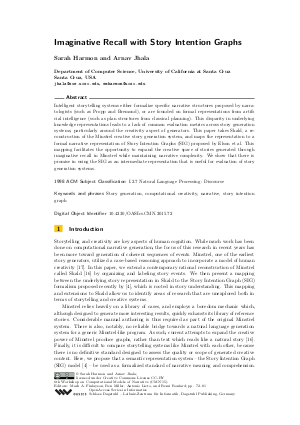Imaginative Recall with Story Intention Graphs
Authors Sarah Harmon, Arnav Jhala
-
Part of:
Volume:
6th Workshop on Computational Models of Narrative (CMN 2015)
Part of: Series: Open Access Series in Informatics (OASIcs) - License:
 Creative Commons Attribution 3.0 Unported license
Creative Commons Attribution 3.0 Unported license
- Publication Date: 2015-08-14
File

PDF
OASIcs.CMN.2015.72.pdf
- Filesize: 377 kB
- 10 pages
Document Identifiers
Subject Classification
Keywords
- Story generation; computational creativity; narrative; story intention graph
Metrics
- Access Statistics
-
Total Accesses (updated on a weekly basis)
0PDF Downloads0Metadata Views
Abstract
Intelligent storytelling systems either formalize specific narrative structures proposed by narratologists (such as Propp and Bremond), or are founded on formal representations from artificial intelligence (such as plan structures from classical planning). This disparity in underlying knowledge representations leads to a lack of common evaluation metrics across story generation systems, particularly around the creativity aspect of generators. This paper takes Skald, a reconstruction of the Minstrel creative story generation system, and maps the representation to a formal narrative representation of Story Intention Graphs (SIG) proposed by Elson et al. This mapping facilitates the opportunity to expand the creative space of stories generated through imaginative recall in Minstrel while maintaining narrative complexity. We show that there is promise in using the SIG as an intermediate representation that is useful for evaluation of story generation systems.
Cite As Get BibTex
Sarah Harmon and Arnav Jhala. Imaginative Recall with Story Intention Graphs. In 6th Workshop on Computational Models of Narrative (CMN 2015). Open Access Series in Informatics (OASIcs), Volume 45, pp. 72-81, Schloss Dagstuhl – Leibniz-Zentrum für Informatik (2015)
https://doi.org/10.4230/OASIcs.CMN.2015.72
BibTex
@InProceedings{harmon_et_al:OASIcs.CMN.2015.72,
author = {Harmon, Sarah and Jhala, Arnav},
title = {{Imaginative Recall with Story Intention Graphs}},
booktitle = {6th Workshop on Computational Models of Narrative (CMN 2015)},
pages = {72--81},
series = {Open Access Series in Informatics (OASIcs)},
ISBN = {978-3-939897-93-4},
ISSN = {2190-6807},
year = {2015},
volume = {45},
editor = {Finlayson, Mark A. and Miller, Ben and Lieto, Antonio and Ronfard, Remi},
publisher = {Schloss Dagstuhl -- Leibniz-Zentrum f{\"u}r Informatik},
address = {Dagstuhl, Germany},
URL = {https://drops.dagstuhl.de/entities/document/10.4230/OASIcs.CMN.2015.72},
URN = {urn:nbn:de:0030-drops-52829},
doi = {10.4230/OASIcs.CMN.2015.72},
annote = {Keywords: Story generation; computational creativity; narrative; story intention graph}
}
Author Details
References
-
Byung-Chull Bae and R. Michael Young. A use of flashback and foreshadowing for surprise arousal in narrative using a plan-based approach. Interactive Storytelling, 4:156-167, 2008.

-
Yun-Gyung Cheong and R. Michael Young. Narrative generation for suspense: Modeling and evaluation. Interactive Storytelling, 4:144-155, 2008.

-
Natalie Dehn. Story generation after TALE-SPIN. In Proceedings of the 7th International Joint Conference on Artificial Intelligence, pages 16-18, 1981.

-
David K. Elson. Detecting story analogies from annotations of time, action and agency. In Proceedings of the LREC 2012 Workshop on Computational Models of Narrative, Istanbul, Turkey, 2012a.

-
David K. Elson. Dramabank: Annotating agency in narrative discourse. In Proceedings of the Eighth International Conference on Language Resources and Evaluation (LREC 2012), Istanbul, Turkey, 2012b.

-
Andrew S. Gordon and Reid Swanson. Identifying personal stories in millions of weblog entries. In Proceedings of the Third International AAAI Conference on Weblogs and Social Media, San Jose, California, 2009.

-
Arthur C. Graesser, Kathy L. Lang, and Richard M. Roberts. Question answering in the context of stories. Journal of Experimental Psychology: General, 120:254–277, 1991.

-
Jerry R. Hobbs and Andrew S. Gordon. Encoding knowledge of commonsense psychology. In Proceedings of the 7th International Symposium on Logical Formalizations of Commonsense Reasoning, pages 107-114, Corfu, Greece, 2005.

-
Sheldon Klein, John F. Aeschlimann, David F. Balsiger, Steve L. Converse, Claudine Court, Mark Foster, Robin Lawo, John D. Oakley, and Joel Smith. Automatic novel writing: A status report. Technical report 186, Computer Science Department, The University of Wisconsin, Madison, 1973.

-
James R. Meehan. Tale-spin, an interactive program that writes stories. In Proceedings of the fifth International Joint Conference on Artificial Intelligence (IJCAI’77), volume 1, pages 91-98, Cambridge, MA, 1977. San Mateo, CA: Morgan Kaufmann.

-
Erik T. Mueller. Modelling space and time in narratives about restaurants. In Literary and Linguistic Computing, volume 4, 2006.

-
James Niehaus and R. Michael Young. A computational model of inferencing in narrative. AAAI Spring Symposium: Intelligent Narrative Technologies II, 2009.

-
Elena Rishes, Stephanie M. Lukin, David K. Elson, and Marilyn A. Walker. Generating different story tellings from semantic representations of narrative. In Koenitz, H., Sezen, T.I., Ferri, G., Haahr, M., Sezen, D., C atak, G. (eds.) ICIDS 2013, LNCS, volume 8230, pages 192-204. Springer, Heidelberg, 2013.

-
Reid Swanson and Arnav Jhala. A crowd-sourced collection of narratives for studying conflict. In Language Resources and Evaluation Conference Workshop on Computational Models of Narrative (LREC 2012), Istanbul, Turkey, 2012.

-
Brandon Tearse. Minstrel Remixed and Skald, 2015. University of California, Santa Cruz, 2012. Web.

-
Brandon Tearse, Peter Mawhorter, Michael Mateas, and Noah Wardrip-Fruin. Skald: Minstrel reconstructed. IEEE Transactions on Computational Intelligence and AI in Games, 6:156–165, 2014.

-
Scott Turner. Minstrel: a computer model of creativity and storytelling. Technical Report CSD-920057, Ph.D. Thesis, Computer Science Department, University of California, Los Angeles, CA, 1992.

